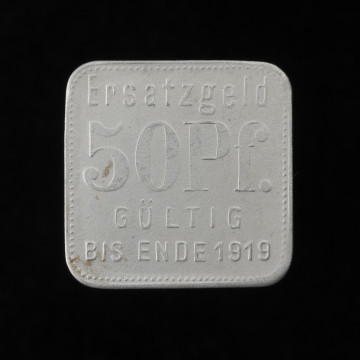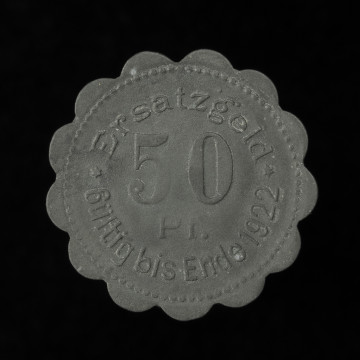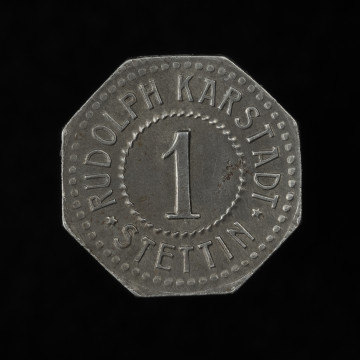
50 pfennig
1918
National Museum in Szczecin
Part of the collection: Scrip
Retail trade runs mainly on low denominations. During the early 20th century in the German Reich, money with a value of less than 1 mark was coinage with denominations of 1, 2, 5, 10, 25 pfennig, and 1/2 mark. Coins up to 25 pfennig were minted in bronze, cupro-nickel and nickel, while 1/2 mark and a mark were minted in silver. As Germany entered the First World War, the Reichsbank began to withdraw bullion coins from circulation. The scarcity of coinage became increasingly acute as the war effort prolonged, especially as the public joined in salvaging bullion from circulation and began hoarding all metal money in the closing stages of the war. A very difficult situation was faced by smaller towns with limited access to coin reserves and for which the circulation of small denomination money played a very important role. In an effort to improve local trade, more and more local authorities began to resolve to issue replacement money of low denominations. The city council of Szczecin also adopted the autonomous issue of replacement coins in 1917 commissioning L. Chr. Lauer of Nuremberg to mint 5- and 10-pfennig coins in zinc. A total of 123,000 coins valued at 5 pfennig and 100,300 coins valued at 10 pfennig were minted. They were given an octagonal form to distinguish them from official issues. The money was to remain in circulation until the end of 1917. After this date, the issuer was bound to exchange it for official legal tender. It was expected that the problem would be solved in 1918 and the mint was expected to replace it with sufficient coinage. This, however, did not happen, and the aforementioned attitude of the public and collectors of new coins added to the inefficiency of the mints. In time, the problem of coinage shortage was resolved by rising inflation, which removed the devalued small denomination coins from circulation. Mieszko Pawłowski
Other names
10 Pfennig, Notgeld
Author / creator
Object type
token coin
Technique
coining
Material
zinc
Origin / acquisition method
acquisition
Creation time / dating
Creation / finding place
Owner
Muzeum Narodowe w Szczecinie (1945- )
Identification number
Location / status

1918
National Museum in Szczecin

1920
National Museum in Szczecin

1901 — 1925
National Museum in Szczecin
DISCOVER this TOPIC
Museum of King Jan III's Palace at Wilanów
DISCOVER this PATH
Educational path